Applied Project Management Methodologies
VerifiedAdded on 2020/03/16
|7
|1307
|33
Project
AI Summary
This project explores the PMBOK and PRINCE2 project management methodologies, highlighting their advantages and disadvantages. It discusses how these methodologies can complement each other and provides insights into their application in real-world scenarios. The research emphasizes the importance of understanding both methodologies for effective project management.
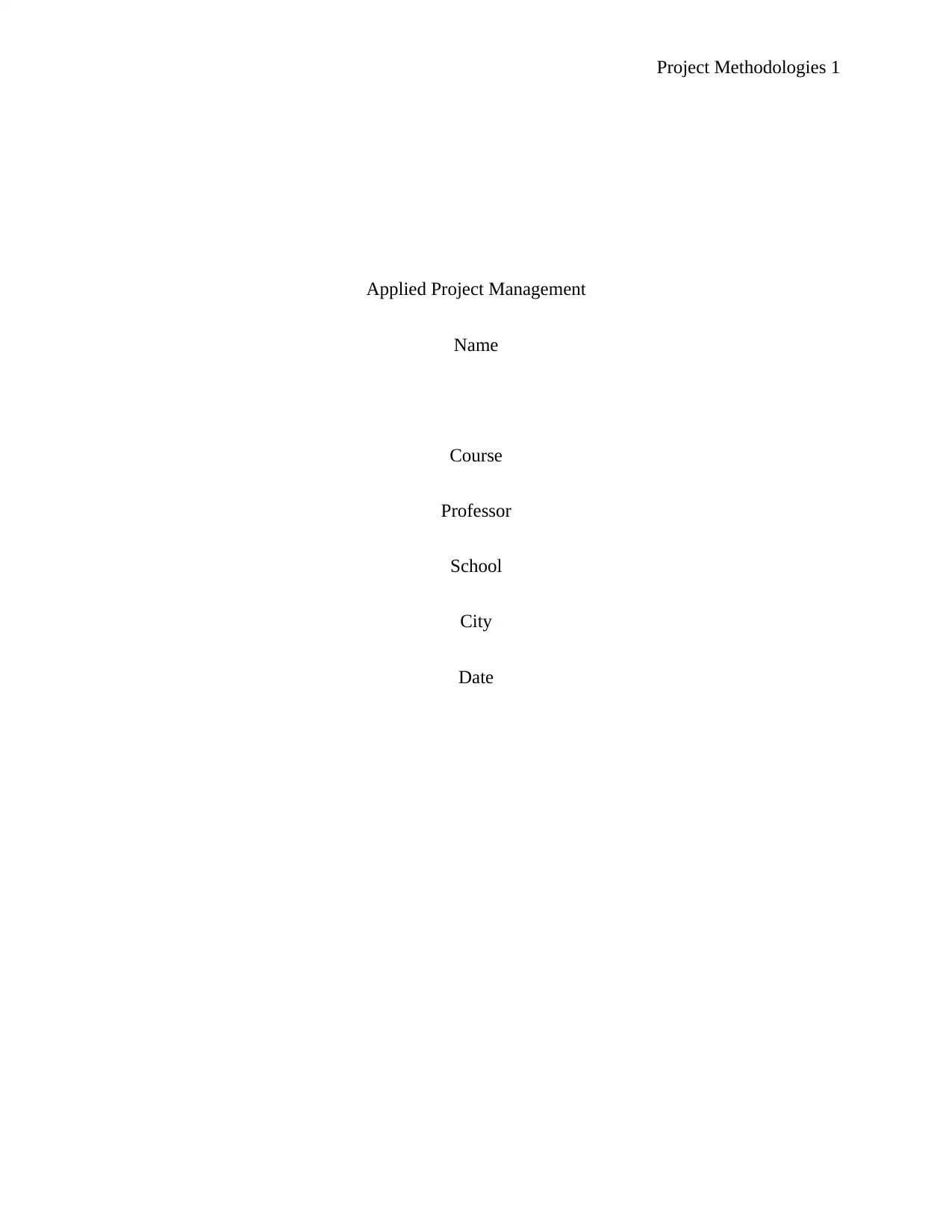
Project Methodologies 1
Applied Project Management
Name
Course
Professor
School
City
Date
Applied Project Management
Name
Course
Professor
School
City
Date
Paraphrase This Document
Need a fresh take? Get an instant paraphrase of this document with our AI Paraphraser
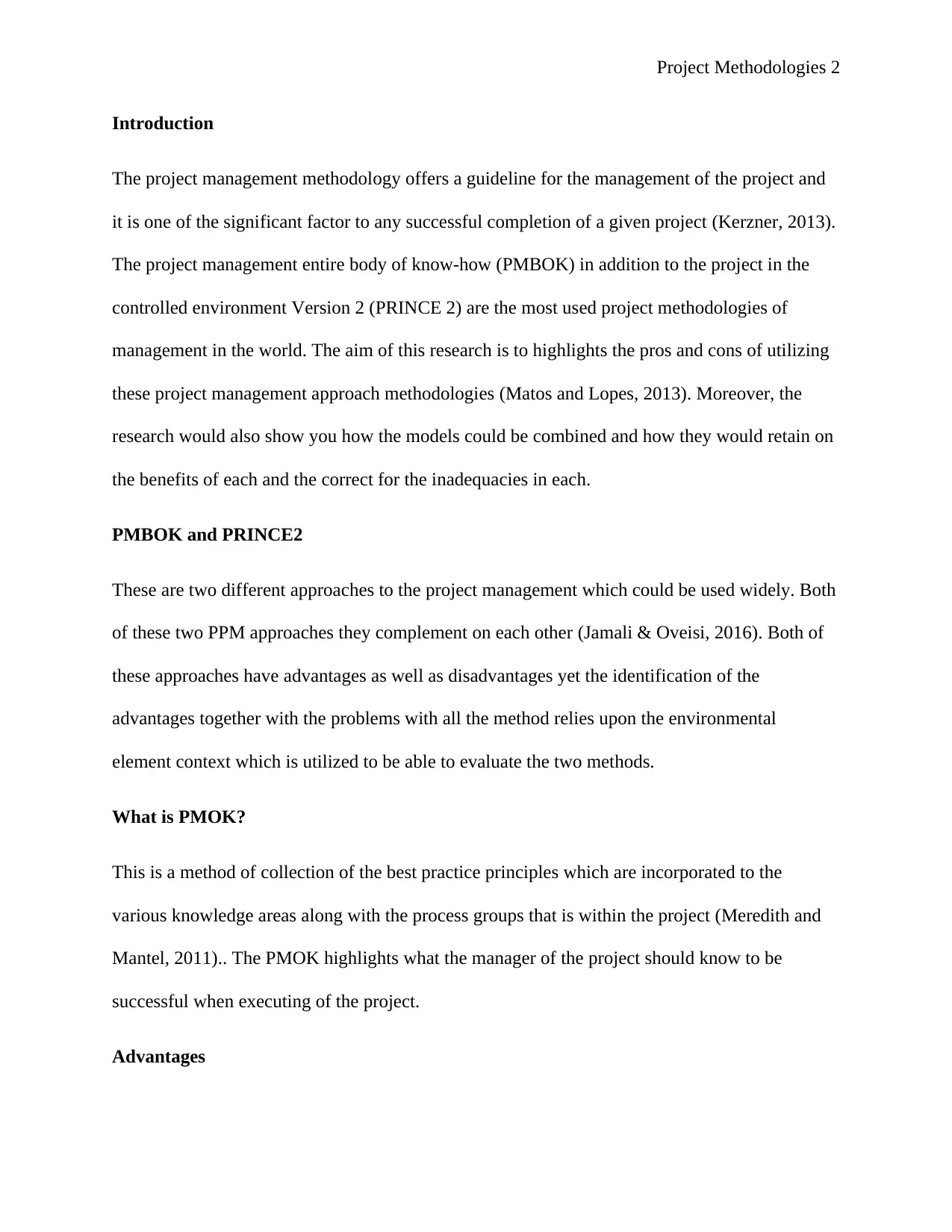
Project Methodologies 2
Introduction
The project management methodology offers a guideline for the management of the project and
it is one of the significant factor to any successful completion of a given project (Kerzner, 2013).
The project management entire body of know-how (PMBOK) in addition to the project in the
controlled environment Version 2 (PRINCE 2) are the most used project methodologies of
management in the world. The aim of this research is to highlights the pros and cons of utilizing
these project management approach methodologies (Matos and Lopes, 2013). Moreover, the
research would also show you how the models could be combined and how they would retain on
the benefits of each and the correct for the inadequacies in each.
PMBOK and PRINCE2
These are two different approaches to the project management which could be used widely. Both
of these two PPM approaches they complement on each other (Jamali & Oveisi, 2016). Both of
these approaches have advantages as well as disadvantages yet the identification of the
advantages together with the problems with all the method relies upon the environmental
element context which is utilized to be able to evaluate the two methods.
What is PMOK?
This is a method of collection of the best practice principles which are incorporated to the
various knowledge areas along with the process groups that is within the project (Meredith and
Mantel, 2011).. The PMOK highlights what the manager of the project should know to be
successful when executing of the project.
Advantages
Introduction
The project management methodology offers a guideline for the management of the project and
it is one of the significant factor to any successful completion of a given project (Kerzner, 2013).
The project management entire body of know-how (PMBOK) in addition to the project in the
controlled environment Version 2 (PRINCE 2) are the most used project methodologies of
management in the world. The aim of this research is to highlights the pros and cons of utilizing
these project management approach methodologies (Matos and Lopes, 2013). Moreover, the
research would also show you how the models could be combined and how they would retain on
the benefits of each and the correct for the inadequacies in each.
PMBOK and PRINCE2
These are two different approaches to the project management which could be used widely. Both
of these two PPM approaches they complement on each other (Jamali & Oveisi, 2016). Both of
these approaches have advantages as well as disadvantages yet the identification of the
advantages together with the problems with all the method relies upon the environmental
element context which is utilized to be able to evaluate the two methods.
What is PMOK?
This is a method of collection of the best practice principles which are incorporated to the
various knowledge areas along with the process groups that is within the project (Meredith and
Mantel, 2011).. The PMOK highlights what the manager of the project should know to be
successful when executing of the project.
Advantages
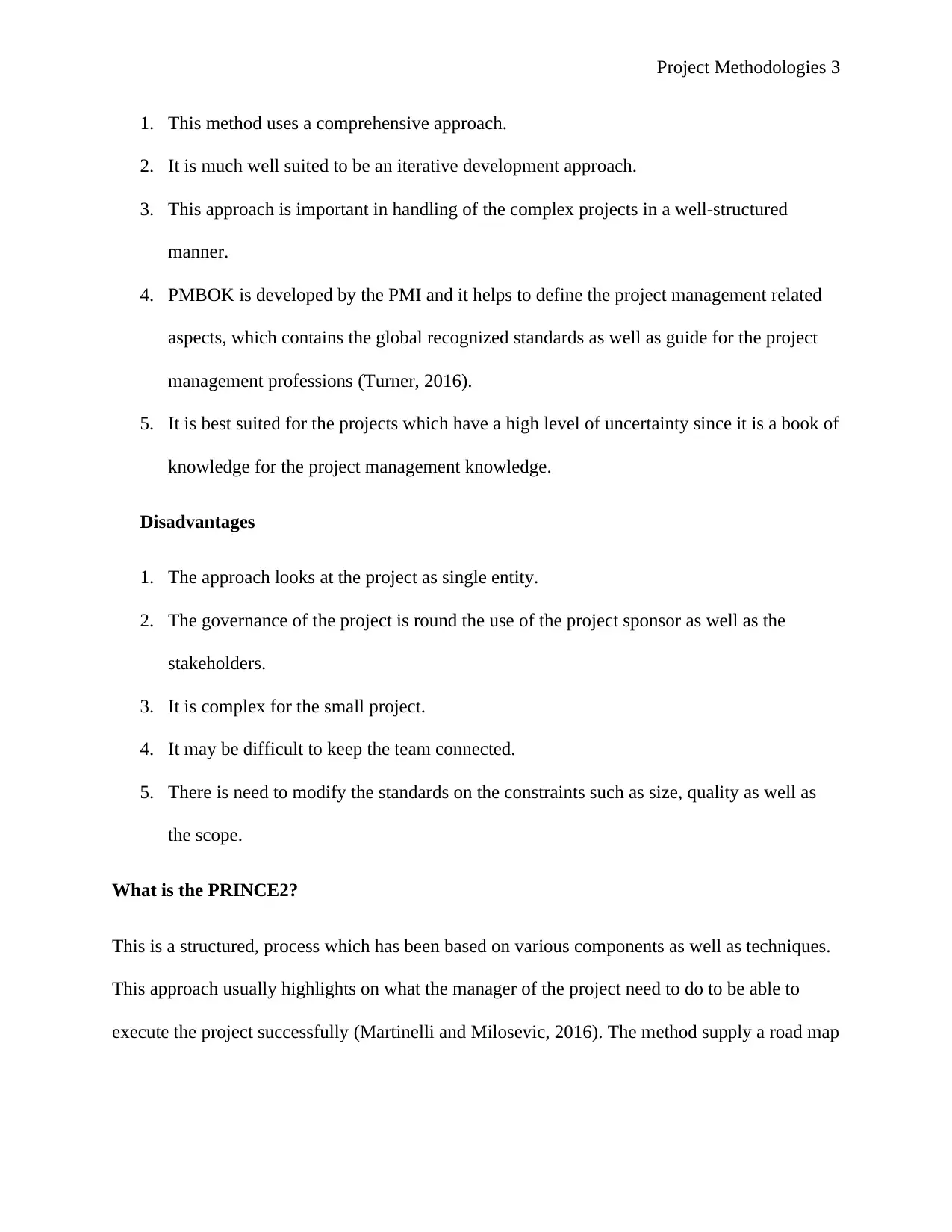
Project Methodologies 3
1. This method uses a comprehensive approach.
2. It is much well suited to be an iterative development approach.
3. This approach is important in handling of the complex projects in a well-structured
manner.
4. PMBOK is developed by the PMI and it helps to define the project management related
aspects, which contains the global recognized standards as well as guide for the project
management professions (Turner, 2016).
5. It is best suited for the projects which have a high level of uncertainty since it is a book of
knowledge for the project management knowledge.
Disadvantages
1. The approach looks at the project as single entity.
2. The governance of the project is round the use of the project sponsor as well as the
stakeholders.
3. It is complex for the small project.
4. It may be difficult to keep the team connected.
5. There is need to modify the standards on the constraints such as size, quality as well as
the scope.
What is the PRINCE2?
This is a structured, process which has been based on various components as well as techniques.
This approach usually highlights on what the manager of the project need to do to be able to
execute the project successfully (Martinelli and Milosevic, 2016). The method supply a road map
1. This method uses a comprehensive approach.
2. It is much well suited to be an iterative development approach.
3. This approach is important in handling of the complex projects in a well-structured
manner.
4. PMBOK is developed by the PMI and it helps to define the project management related
aspects, which contains the global recognized standards as well as guide for the project
management professions (Turner, 2016).
5. It is best suited for the projects which have a high level of uncertainty since it is a book of
knowledge for the project management knowledge.
Disadvantages
1. The approach looks at the project as single entity.
2. The governance of the project is round the use of the project sponsor as well as the
stakeholders.
3. It is complex for the small project.
4. It may be difficult to keep the team connected.
5. There is need to modify the standards on the constraints such as size, quality as well as
the scope.
What is the PRINCE2?
This is a structured, process which has been based on various components as well as techniques.
This approach usually highlights on what the manager of the project need to do to be able to
execute the project successfully (Martinelli and Milosevic, 2016). The method supply a road map
⊘ This is a preview!⊘
Do you want full access?
Subscribe today to unlock all pages.

Trusted by 1+ million students worldwide
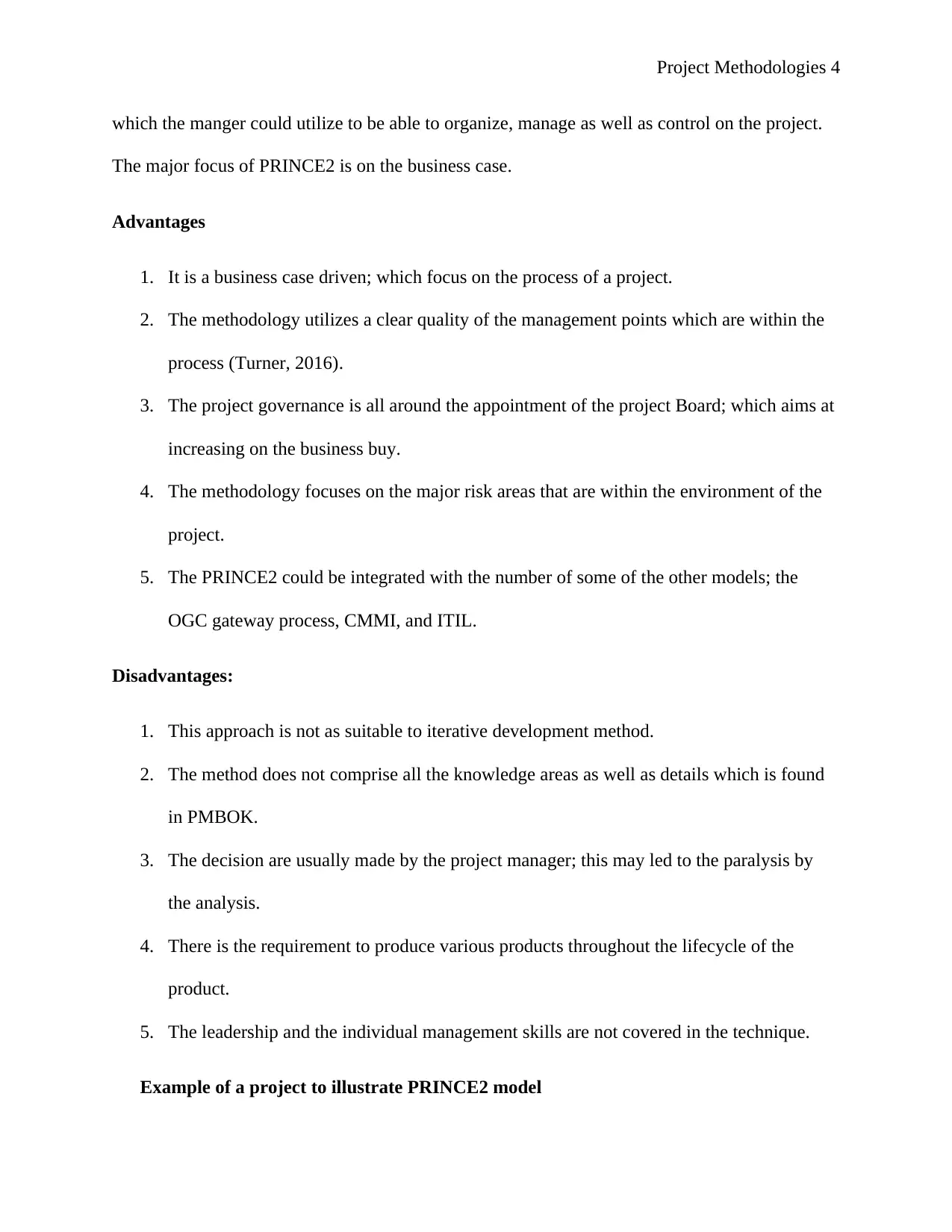
Project Methodologies 4
which the manger could utilize to be able to organize, manage as well as control on the project.
The major focus of PRINCE2 is on the business case.
Advantages
1. It is a business case driven; which focus on the process of a project.
2. The methodology utilizes a clear quality of the management points which are within the
process (Turner, 2016).
3. The project governance is all around the appointment of the project Board; which aims at
increasing on the business buy.
4. The methodology focuses on the major risk areas that are within the environment of the
project.
5. The PRINCE2 could be integrated with the number of some of the other models; the
OGC gateway process, CMMI, and ITIL.
Disadvantages:
1. This approach is not as suitable to iterative development method.
2. The method does not comprise all the knowledge areas as well as details which is found
in PMBOK.
3. The decision are usually made by the project manager; this may led to the paralysis by
the analysis.
4. There is the requirement to produce various products throughout the lifecycle of the
product.
5. The leadership and the individual management skills are not covered in the technique.
Example of a project to illustrate PRINCE2 model
which the manger could utilize to be able to organize, manage as well as control on the project.
The major focus of PRINCE2 is on the business case.
Advantages
1. It is a business case driven; which focus on the process of a project.
2. The methodology utilizes a clear quality of the management points which are within the
process (Turner, 2016).
3. The project governance is all around the appointment of the project Board; which aims at
increasing on the business buy.
4. The methodology focuses on the major risk areas that are within the environment of the
project.
5. The PRINCE2 could be integrated with the number of some of the other models; the
OGC gateway process, CMMI, and ITIL.
Disadvantages:
1. This approach is not as suitable to iterative development method.
2. The method does not comprise all the knowledge areas as well as details which is found
in PMBOK.
3. The decision are usually made by the project manager; this may led to the paralysis by
the analysis.
4. There is the requirement to produce various products throughout the lifecycle of the
product.
5. The leadership and the individual management skills are not covered in the technique.
Example of a project to illustrate PRINCE2 model
Paraphrase This Document
Need a fresh take? Get an instant paraphrase of this document with our AI Paraphraser
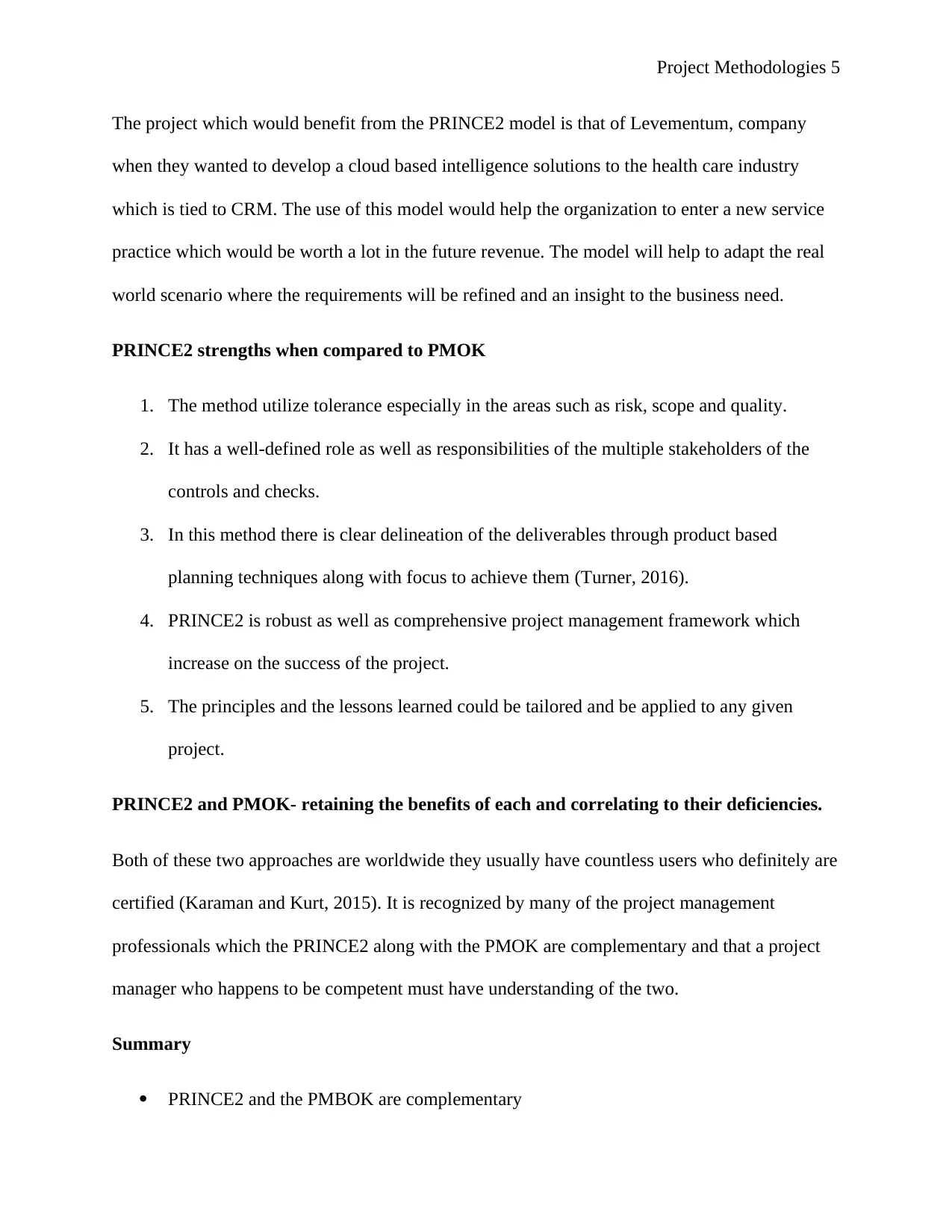
Project Methodologies 5
The project which would benefit from the PRINCE2 model is that of Levementum, company
when they wanted to develop a cloud based intelligence solutions to the health care industry
which is tied to CRM. The use of this model would help the organization to enter a new service
practice which would be worth a lot in the future revenue. The model will help to adapt the real
world scenario where the requirements will be refined and an insight to the business need.
PRINCE2 strengths when compared to PMOK
1. The method utilize tolerance especially in the areas such as risk, scope and quality.
2. It has a well-defined role as well as responsibilities of the multiple stakeholders of the
controls and checks.
3. In this method there is clear delineation of the deliverables through product based
planning techniques along with focus to achieve them (Turner, 2016).
4. PRINCE2 is robust as well as comprehensive project management framework which
increase on the success of the project.
5. The principles and the lessons learned could be tailored and be applied to any given
project.
PRINCE2 and PMOK- retaining the benefits of each and correlating to their deficiencies.
Both of these two approaches are worldwide they usually have countless users who definitely are
certified (Karaman and Kurt, 2015). It is recognized by many of the project management
professionals which the PRINCE2 along with the PMOK are complementary and that a project
manager who happens to be competent must have understanding of the two.
Summary
PRINCE2 and the PMBOK are complementary
The project which would benefit from the PRINCE2 model is that of Levementum, company
when they wanted to develop a cloud based intelligence solutions to the health care industry
which is tied to CRM. The use of this model would help the organization to enter a new service
practice which would be worth a lot in the future revenue. The model will help to adapt the real
world scenario where the requirements will be refined and an insight to the business need.
PRINCE2 strengths when compared to PMOK
1. The method utilize tolerance especially in the areas such as risk, scope and quality.
2. It has a well-defined role as well as responsibilities of the multiple stakeholders of the
controls and checks.
3. In this method there is clear delineation of the deliverables through product based
planning techniques along with focus to achieve them (Turner, 2016).
4. PRINCE2 is robust as well as comprehensive project management framework which
increase on the success of the project.
5. The principles and the lessons learned could be tailored and be applied to any given
project.
PRINCE2 and PMOK- retaining the benefits of each and correlating to their deficiencies.
Both of these two approaches are worldwide they usually have countless users who definitely are
certified (Karaman and Kurt, 2015). It is recognized by many of the project management
professionals which the PRINCE2 along with the PMOK are complementary and that a project
manager who happens to be competent must have understanding of the two.
Summary
PRINCE2 and the PMBOK are complementary
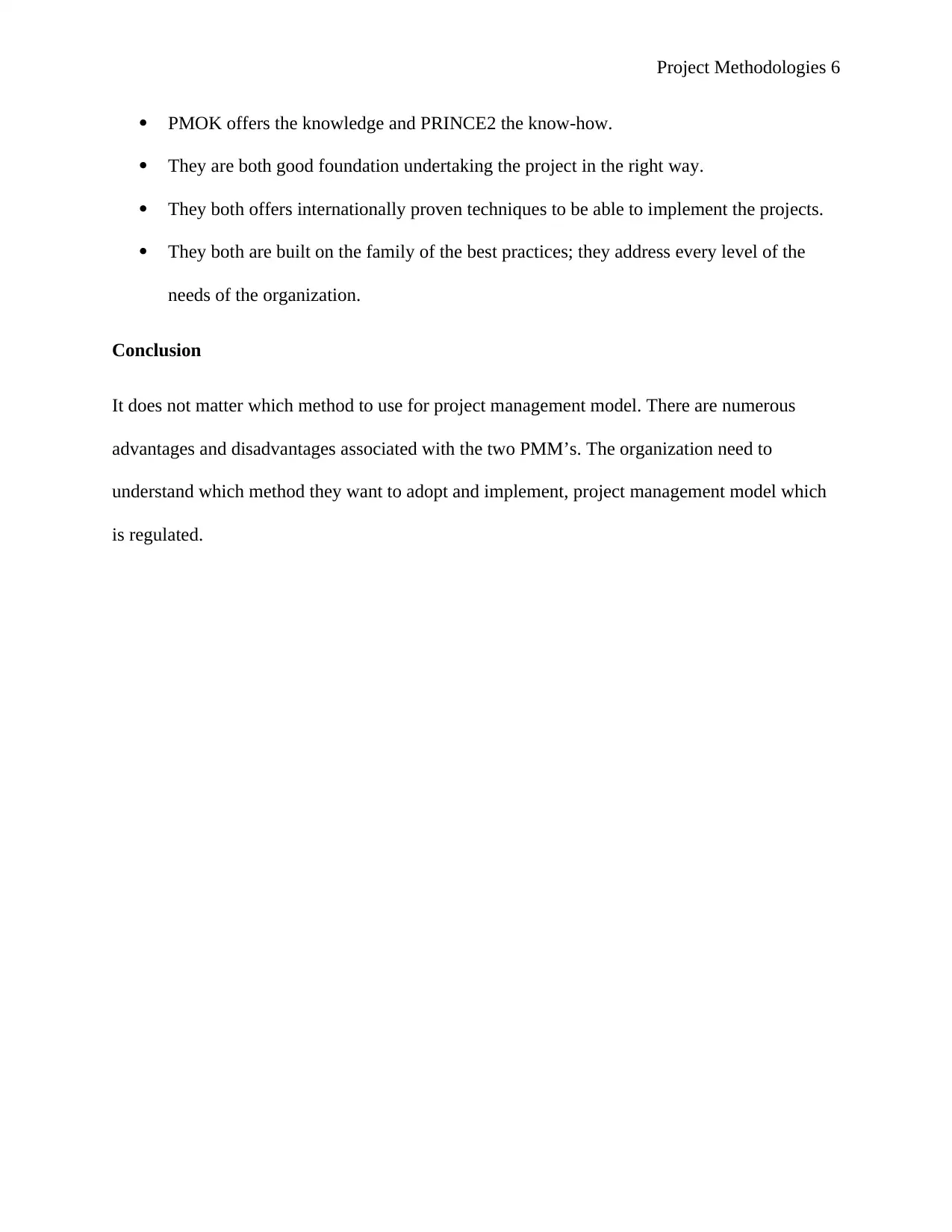
Project Methodologies 6
PMOK offers the knowledge and PRINCE2 the know-how.
They are both good foundation undertaking the project in the right way.
They both offers internationally proven techniques to be able to implement the projects.
They both are built on the family of the best practices; they address every level of the
needs of the organization.
Conclusion
It does not matter which method to use for project management model. There are numerous
advantages and disadvantages associated with the two PMM’s. The organization need to
understand which method they want to adopt and implement, project management model which
is regulated.
PMOK offers the knowledge and PRINCE2 the know-how.
They are both good foundation undertaking the project in the right way.
They both offers internationally proven techniques to be able to implement the projects.
They both are built on the family of the best practices; they address every level of the
needs of the organization.
Conclusion
It does not matter which method to use for project management model. There are numerous
advantages and disadvantages associated with the two PMM’s. The organization need to
understand which method they want to adopt and implement, project management model which
is regulated.
⊘ This is a preview!⊘
Do you want full access?
Subscribe today to unlock all pages.

Trusted by 1+ million students worldwide
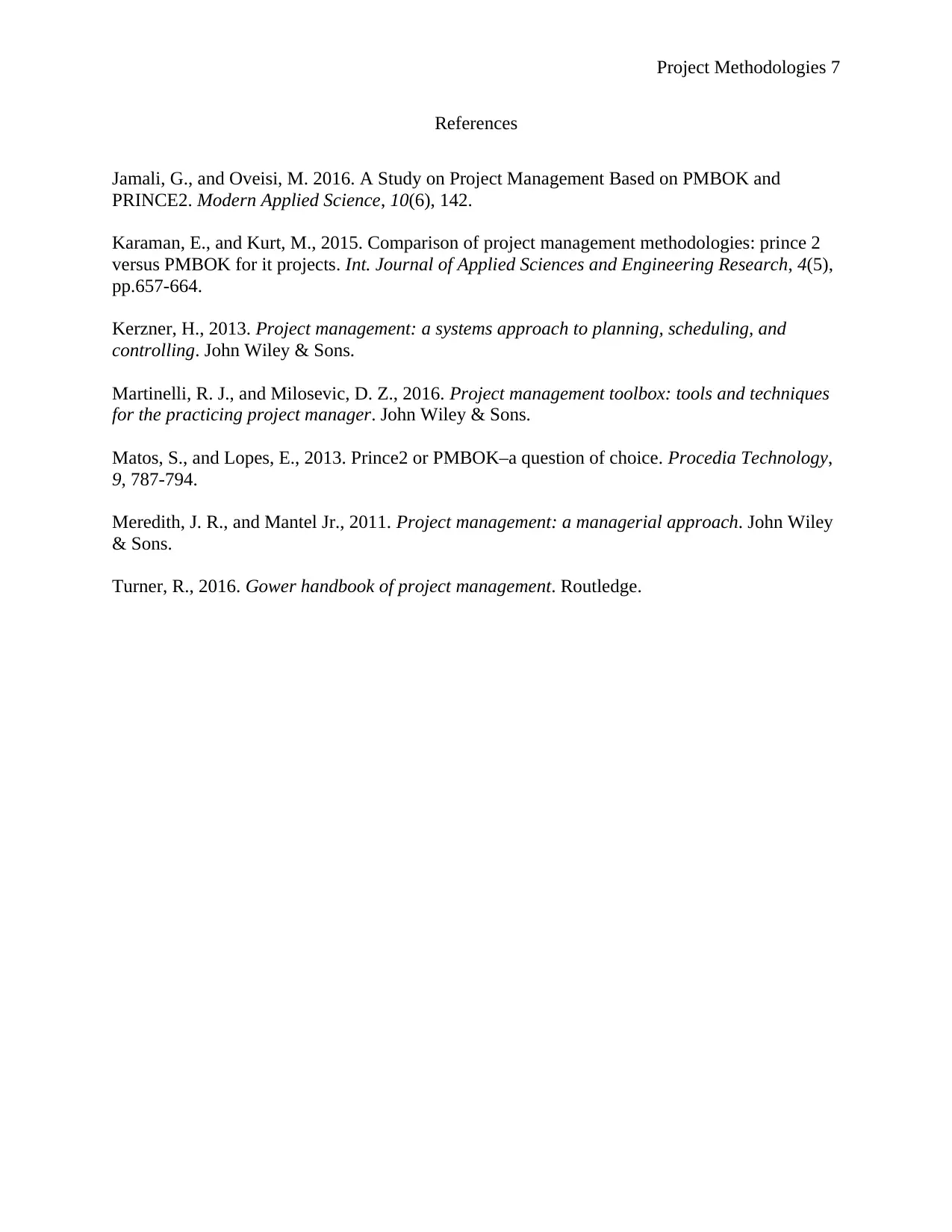
Project Methodologies 7
References
Jamali, G., and Oveisi, M. 2016. A Study on Project Management Based on PMBOK and
PRINCE2. Modern Applied Science, 10(6), 142.
Karaman, E., and Kurt, M., 2015. Comparison of project management methodologies: prince 2
versus PMBOK for it projects. Int. Journal of Applied Sciences and Engineering Research, 4(5),
pp.657-664.
Kerzner, H., 2013. Project management: a systems approach to planning, scheduling, and
controlling. John Wiley & Sons.
Martinelli, R. J., and Milosevic, D. Z., 2016. Project management toolbox: tools and techniques
for the practicing project manager. John Wiley & Sons.
Matos, S., and Lopes, E., 2013. Prince2 or PMBOK–a question of choice. Procedia Technology,
9, 787-794.
Meredith, J. R., and Mantel Jr., 2011. Project management: a managerial approach. John Wiley
& Sons.
Turner, R., 2016. Gower handbook of project management. Routledge.
References
Jamali, G., and Oveisi, M. 2016. A Study on Project Management Based on PMBOK and
PRINCE2. Modern Applied Science, 10(6), 142.
Karaman, E., and Kurt, M., 2015. Comparison of project management methodologies: prince 2
versus PMBOK for it projects. Int. Journal of Applied Sciences and Engineering Research, 4(5),
pp.657-664.
Kerzner, H., 2013. Project management: a systems approach to planning, scheduling, and
controlling. John Wiley & Sons.
Martinelli, R. J., and Milosevic, D. Z., 2016. Project management toolbox: tools and techniques
for the practicing project manager. John Wiley & Sons.
Matos, S., and Lopes, E., 2013. Prince2 or PMBOK–a question of choice. Procedia Technology,
9, 787-794.
Meredith, J. R., and Mantel Jr., 2011. Project management: a managerial approach. John Wiley
& Sons.
Turner, R., 2016. Gower handbook of project management. Routledge.
1 out of 7
Related Documents
Your All-in-One AI-Powered Toolkit for Academic Success.
+13062052269
info@desklib.com
Available 24*7 on WhatsApp / Email
![[object Object]](/_next/static/media/star-bottom.7253800d.svg)
Unlock your academic potential
Copyright © 2020–2025 A2Z Services. All Rights Reserved. Developed and managed by ZUCOL.





